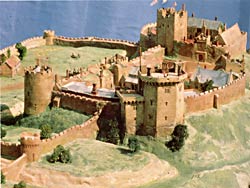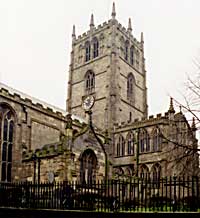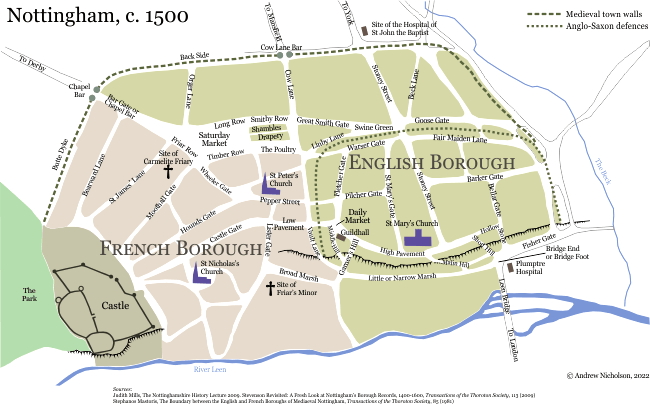
Overview: before 1500

Nottingham castle, c.1500 (model by P Dixon and D Taylor).
Nottingham was first mentioned in the written record was in 868 when the defensible position of the town attracted the Danes, but it was of only minor importance until 920 when the first bridge over the River Trent was built. The town quickly became a centre of royal administration. The earliest settlement was on St Mary's Hill (now the Lace Market area), and included various sites in the Halifax Place area. St Mary's Church was originally a Saxon building, all trace of which has disappeared.
The Castle, built 1067-8, was originally an earthwork and timber defence. It was transformed by Henry II into a royal palace regularly visited by medieval monarchs. Part of the stone-built outer bailey is all that survives of the Norman castle, together with the mid-thirteenth century gateway, restored in the nineteenth century.
Although several monarchs spent lavishly on building, repairing and reconstructing the buildings, royal visits were short and for most of the time the castle was empty. This was hardly the image to be expected from the Robin Hood tales. Nor was there much communication with the town, because craftsmen and builders were often brought from a distance rather than hired locally.
Occasionally events connected with the castle had a significant impact locally. In 1140 buildings were destroyed in a fire in the town after the castle came under attack by Robert of Gloucester. Less important for Nottingham, but perhaps the most dramatic incident in the history of the castle, was the coup of 1330 in which Queen Isabella and Roger Mortimer were overthrown. Conspirators supporting King Edward III entered the castle through the underground passage subsequently known as ‘Mortimer's Hole'. The castle was retaken, Mortimer was executed, and the king’s authority was restored.
The important strategic position of the castle also meant that Nottingham was a focal point during the Wars of the Roses, at the time of the Pilgrimage of Grace in 1536, and during the civil wars in the 1640s.

St Mary's church (photo: A Nicholson, 2001).
Perhaps the most lasting local influence of the castle was the development of a French or Norman borough in the area now known as castle rock. This affected the topography of the town. The Saxon settlement around St Mary's Hill and the French borough around the castle gradually developed towards each other to form a single town.
We know that between the thirteenth and sixteenth centuries the town was partially surrounded by a wall, and the medieval street pattern is reasonably clear even today. Only a few medieval buildings have survived. They include the Salutation and The Bell, both of which have fifteenth century timbers and, like many Nottingham inns, extensive cellars cut out of the sandstone. There were three parish churches, St Mary’s, St Peter’s and St Nicholas’s, and a number of religious houses and hospitals.
A series of charters granted to Nottingham by the Crown between 1155 and 1449 increased the powers of self-government, but the English (Saxon) and French (Norman) boroughs retained separate administrations even after the town acquired a mayor in 1284.
Late medieval Nottingham was moderately prosperous, and in 1449 Henry VI granted the town self-governing powers through a corporate charter. Local political power passed into the hands of a small group of men, and a powerful oligarchy emerged which survived until the corporation was reformed in 1835.
